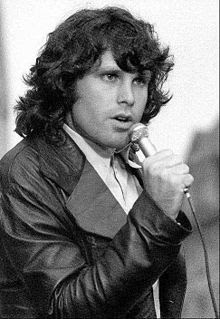
 "The Scene": [Covered] from Haight Asbury, through New York, New Haven, and Miami
"The Scene": [Covered] from Haight Asbury, through New York, New Haven, and MiamiIn the film The Doors director Oliver Stone is telling the story of the hippie / mind expansion / flower power generation parallel with the rise and fall of Jim Morrison. Stone's film captures the early years of Morrison experimenting with art, poetry, peyote and toying with mind expansion, Irish whiskey, sugar cubes, jazz cigarettes and more and more and more.
Take the notorious Miami arrest-gig: just like the Tampa concerts (five hours NNW) I saw at the time -- joints everywhere, fights breaking out, nobody actually sitting down. I was only 13; good thing I didn't know the right drugs to take.
As for Morrison, we learn, but I'll leave it to the poet critics to judge the merits of what he produced.
*****************
"I don’t know Just where I’m going But I’m Goin’ to try For the kingdom If I can ’Cause it makes me feel like I’m a man When I put a spike into my vein Then I tell you things aren’t quite the same When I’m rushing on my run And I feel just like Jesus’ son And I guess I just don’t know And I guess that I just don’t know ...."
(--from Heroin by Lou Reed,
performed on the album Velvet Underground & Nico,
as Morrison meets Andy Warhol and most noteworthy, the Nordic princess Nico)
(--from Heroin by Lou Reed,
performed on the album Velvet Underground & Nico,
as Morrison meets Andy Warhol and most noteworthy, the Nordic princess Nico)
Setting the mythological parallels aside, metaphysical thinking-man's-hippie logic still held sway, Oliver Stone's The Doors is a first class trip down counterculture lane. Very, very high: mesmerizing at times and also terrifyingly stark at others.
Using hallucinogenic drugs to follow a shaman's path -- all the time drinking and helping invent post-'67 rock star. Easy to dismiss in light of Castaneda's work and time passing, but back "in the day", well dude, all that talent, why not ride the tiger? Morrison definitely did.
*****************
'Riding that tiger after whipping it's eyes' Morrison, set to the quasi-Celtic introduction to Carmina Burana. Here Stone completes the transition from the pop excess of the Warhol party to "derangement of the senses" through a Wiccan doorway. Headed toward "enlightenment", the jet fuel of attitude, culture, whiskey and coke. Dude, enlightenment?: maybe insight at best.
*****************
Jim Morrison: An American Dionysus?
Oliver Stone certain thinks so. This time out, however, Stone's thesis is wrapped in the billowing shroud of Morrison's life and legend. Stone usually heavy-handed direction fades. Comparing Morrison to Dionysus moves Stone's thesis along, but the comparison is premature. In touch with a Nagual, maybe -- I couldn't know, not being a shaman.
**************************************************************










